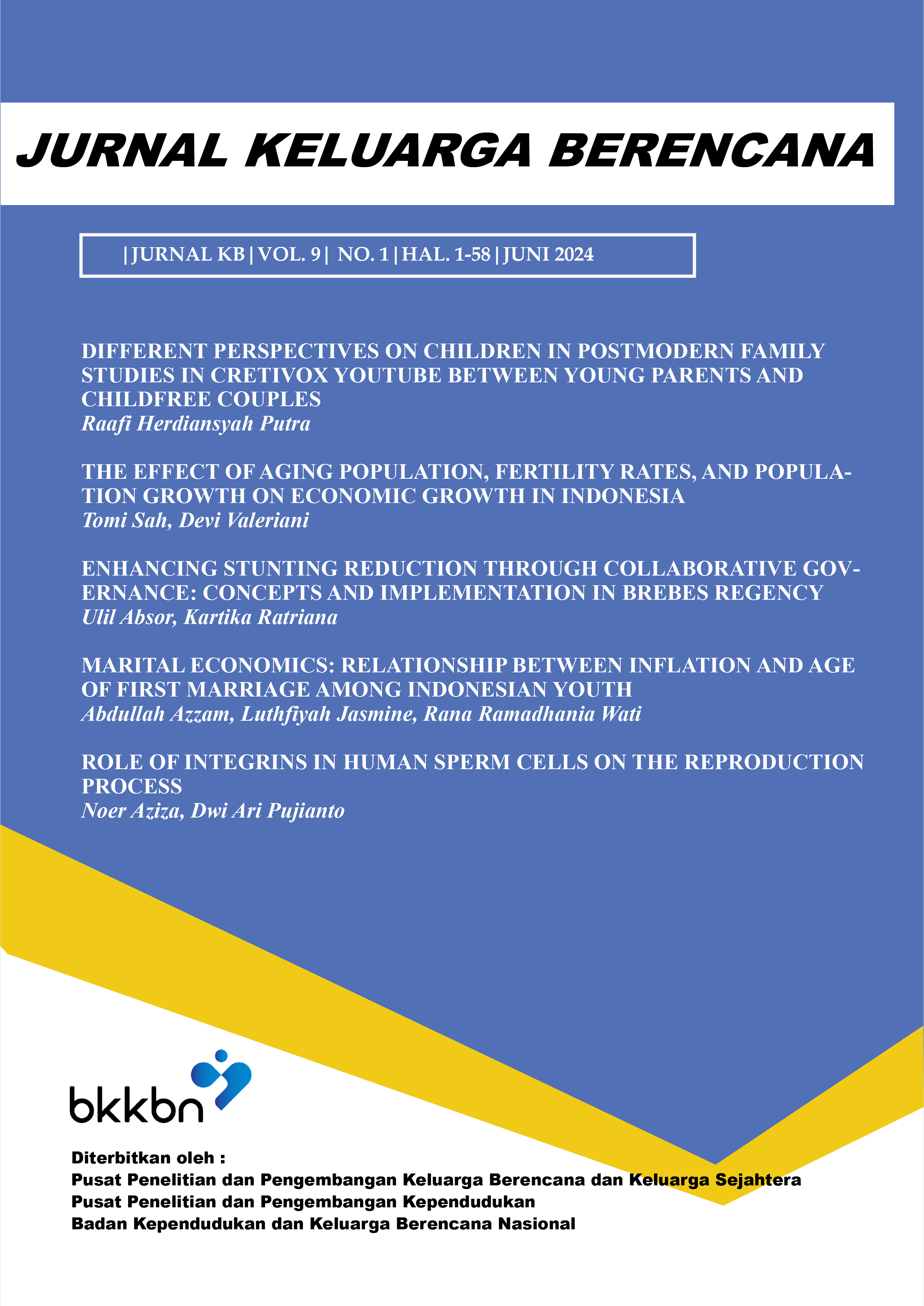DIFFERENT PERSPECTIVES ON CHILDREN IN POSTMODERN FAMILY STUDIES IN CRETIVOX YOUTUBE BETWEEN YOUNG PARENTS AND CHILDFREE COUPLES
DOI:
https://doi.org/10.37306/5vz2cn68Keywords:
Children, Postmodern Family, PerspectivesAbstract
The childfree phenomenon has become a popular issue in Indonesia recently. Many articles and media content address the topic of being childfree, including the eighth episode of the YouTube account Cretivox. This episode features two married couples with differing perspectives on having children. The purpose of this study is to explore the differences in perspectives on children in the household from the viewpoints of childfree couples and young parents, analyzed through a postmodern family approach. This research employs a qualitative approach and a descriptive method. Data collection involves documents from the Cretivox YouTube account and relevant journal articles. The results indicate that out of five questions posed, four reveal differing views: preparation before marriage, popular statements about children, the urgency of having offspring, and household harmony. For the question regarding children guaranteeing support in old age, both couples agreed to disagree with the statement.
Downloads
References
Adyani, K., Wulandari, C. L., & Isnaningsih, E. V. (2023). Faktor –Faktor yang Mempengaruhi Pengetahuan Calon Pengantin dalam Kesiapan Menikah. Jurnal Syntax Health Sains, 4(1), 109–119. https://doi.org/https://doi.org/10.46799/jhs.v4i1.787E-ISSN
Afiati, T., Wafiroh, A., & Sofyan, M. S. (2022). Upaya Pasangan Suami Istri Tidak Memiliki Keturunan Dalam Mempertahankan Keharmonisan Rumah Tangga (Studi Kasus di Desa Siru Kabupaten Manggarai Barat NTT). Al-Ihkam : Jurnal Hukum Keluarga, 14(2), 161–184. https://doi.org/10.20414/alihkam.v14i2.6927
APA Dictionary. “Permeable Family” Retrieved from https://dictionary.apa.org/permeable-family, accessed on 13 May 2024
Ardiansyah, Risnita, & Jailani, M. S. (2023). Teknik Pengumpulan Data Dan Instrumen Penelitian Ilmiah Pendidikan Pada Pendekatan Kualitatif dan Kuantitatif. Ihsan: Jurnal Pendidikan Islam, 1(2), 1–9. https://doi.org/10.61104/ihsan.v1i2.57
Awaru, O. tenri. (2021). Sosiologi Keluarga (R. Rerung, Ed.). Bandung: Penerbit Media Sains Indonesia.
Az Zahwa, R. P. (2023). Stigmatisasi Masyarakat Terhadap Keharmonisan Keluarga Childless [Undergraduate Thesis]. Universitas Islam Negeri Syarif Hidayatullah Jakarta.
Denada, V. S., Fikri, A., & Sokarina, A. (2022). Makna Investasi Pada Anak Dalam Mitos “Banyak Anak Banyak Rezeki”: Studi Fenomenologi. Jurnal Ilmiah Akuntansi Peradaban, VIII(1). https://doi.org/10.24252/jiap.v8i1.28939
Fillaili, N. N., & Martini. (2023). Trend Bebas Anak Child Free di Kalangan Pasangan Milenial Pasca Menikah. Edukasi IPS, 7(1), 36–44. https://doi.org/10.21009/EIPS.007.01.05
Hanandita, T. (2022). Konstruksi Masyarakat Tentang Hidup Tanpa Anak Setelah Menikah. Jurnal Analisa Sosiologi, 11(1), 126–136. https://doi.org/10.20961/jas.v11i1.56920
Jamaludin, A. N. (2021). Metode Penelitian Sosial. Bandung: Pusat Penelitian dan Penerbitan UIN Bandung.
Kurniasih, G., & Hastjarjo, S. (2023). Pengaruh Reputasi, Kepercayaan Subscriber, dan Corporate Identity Terhadap Loyalitas Subscriber Pada Kanal Youtube Cretivox Setelah Adanya Isu Plagiat. Jurnal Kommas: Komunikasi Massa, 1(1), 1–19. ISSN: 1411-268x
Lestari, P., & Pratiwi, P. H. (2018). PERUBAHAN DALAM STRUKTUR KELUARGA. Jurnal Dimensia , 7(1), 23–44. https://doi.org/10.21831/dimensia.v7i1.21053
Martono, N. (2021). Sosiologi Perubahan Sosial: Perspektif Klasik, Modern, Postmodern, dan Postkolonial. Depok: PT Rajagrafindo Persada.
Mufasirin, I. (2021). BANYAK ANAK BANYAK REZEKI PERSPEKTIF PERLINDUNGAN ANAK PADA MASYARAKAT PINGGIRAN ( Studi Masyarakat Dusun Mijil Desa Grogol Kecamatan Sawoo ) [Graduate Thesis]. IAIN Ponorogo.
Nawawi, H. (2015). Metode Penelitian Bidang Sosial. Yogyakarta: Gajah Mada University Press.
Nugroho, D. A., Alfarisy, F., Kurniawan, A. N., & Sarita, E. R. (2022). Tren Childfree dan Unmarried di kalangan Masyarakat Jepang. COMSERVA: Jurnal Penelitian Dan Pengabdian Masyarakat, 1(11). https://doi.org/10.59141/comserva.v1i11.153
Putra, R. H. (2024). Persepsi dan Pengambilan Keputusan Childfree di Kalangan Mahasiswa Indonesia: Studi di Universitas Islam Negeri Sunan Gunung Djati Bandung [Undergraduate Thesis]. Universitas Islam Negeri Sunan Gunung Djati.
Sapinatunajah, P., Hermansyah, T., & Nasichah. (2022). Analisis Content Influencer Gitasav Pada Statement “Childfree” Dalam Prespektif Islam. Jurnal Ilmu Komunikasi Dan Media Sosial (JKOMDIS), 2(3), 180–186. https://doi.org/10.47233/jkomdis.v2i1.266
Setiawan, J. (2018). Pemikiran Postmodernisme Dan Pandangannya Terhadap Ilmu Pengetahuan. Jurnal Filsafat, 28(1), 25–46. https://doi.org/10.22146/jf.33296
Siswanto, A. W., & Nurhasanah, N. (2022). Analisis Fenomena Childfree di Indonesia. Bandung Converence Series: Islamic Family Law, 2(2). https://doi.org/10.29313/bcsifl.v2i2.2684
StudySmarter. (2023). Postmodernist Perspective on The Family. Retrieved from https://www.studysmarter.co.uk/explanations/social-studies/families-and-households/postmodernist-perspective-on-the-family/ accessed on 8 June 2024
Sugiyono. (2013). Metode Penelitian Kuantitatif, Kualitatif, dan R&D. Bandung: Alfabeta.
Tunggono, V. (2021). Childfree & Happy. Yogyakarta: Buku Mojok Group.
Wardhani, N. S., Ramadhani, S., & Putri, L. (2020). Tanggung Jawab Orang Tua dalam Permasalahan Pekerja Anak di Sektor Informal dalam Kajian Sosiologis Yuridis. University of Bengkulu Law Journal, 5(2). https://doi.org/10.33369/ubelaj.5.2.119-136
Downloads
Published
Issue
Section
License
Copyright (c) 2024 Raafi Herdiansyah Putra

This work is licensed under a Creative Commons Attribution-NonCommercial-NoDerivatives 4.0 International License.
Deprecated: json_decode(): Passing null to parameter #1 ($json) of type string is deprecated in /var/www/html/ejurnal/plugins/generic/citations/CitationsPlugin.php on line 68







